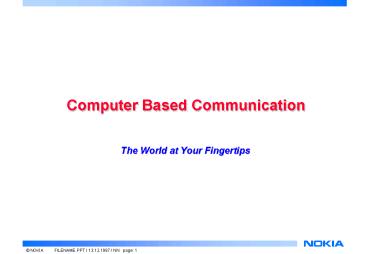Computer Based Communication - PowerPoint PPT Presentation
1 / 14
Title:
Computer Based Communication
Description:
... schedules tasks, manages storage, and handles communication ... office furniture/accessories. Consider: You want to expand, to get more employees? Consider: ... – PowerPoint PPT presentation
Number of Views:26
Avg rating:3.0/5.0
Title: Computer Based Communication
1
Computer Based Communication
- The World at Your Fingertips
2
- History of Computers
- What is a Computer
- Changes in the way we live
- Changes in the way we work
- Evolution of responsiveness
- What is DTC
- Audio/Video Conferencing
- Document/Application sharing
- Whiteboarding
3
- What is DTC
- IP Telephony
- Internet Presentations
- E-mail, Voice/Video E-mail
- Requirements
- Nokia Solution
- Why to use DTC
- USB
- Typical applications
4
- 3000 BC - Invention of the abacus
- 1621 - Slide rule is invented (used until mid
1970's) - 1800 - First punch cards for storing data are
invented by Jacquard. - 1820s - Difference Engine (Charles Babbage)
- 1943 - First electronic general purpose computer,
the ENIAC, is invented - 1944 - First stored program computer is invented,
the EDVAC - 1948 - First commercial computer, the UNIVAC,
created
5
- 1948 - invention of transistor led to second
generation of computers - 1958 - At Texas Instruments, Jack Kilby builds
the first integrated circuit - Computers based on the first generation
integrated circuit technology became known as the
third generation of computers - 1970s - Development of the microprocessor
- Fourth Generation of computers (PCs) are based on
the microprocessors - late1980s - SMP (symmetric multiprocessing)
systems use multiple microprocessors - Fifth
Generation of computers - late1990s - Standard High-Volume (SHV) server
motherboard, system design building block
containing all the components necessary - from
processors and memory to SMP, and I/O-bus
hardware
6
Computer - an electronic device that has the
ability to store, retrieve, and process data, and
can be programmed with instructions that it
remembers.
Input
Processing
Output
HARDWARE
SOFTWARE
7
Input
Output
Keyboard, mouse, Video camera, etc
Printer, speech, etc
Operating System - the main control program of a
computer that schedules tasks, manages storage,
and handles communication with peripherals. The
operating system presents a basic user interface
when no applications are open, and all
applications must communicate with the operating
system.
8
CPU (Central Processing Unit) controls the
operation of a computer. Units within the CPU
perform arithmetic and logical operations and
decode and execute instructions.
Microprocessor - a computer with its entire CPU
contained on one integrated circuit.
Digital Machine Uses Binary System
CODEC - 1.Coder/decoder. A device that converts
analog signals to digital to be read by a
computer or transmitted over a network, and
converts the digital signals back to
analog. 2.Compression/decompression. A two-step
process used on very large multimedia files.
Files are compressed, then expanded to their
original size in order to play them on the
computer.
9
Videoconferencing
Text
Audiographics
DSP Multimedia Technology
Voice/Data/Fax/E-mail
Image
Telephony
Voice
Business Presentations
Audio
Games Entertainment
Video
Multimedia Databases
Kiosks
Graphics
10
Changes in the Way we Live
Before
Now
movement
movement
People
City
People
Rural Areas
Nicer settings, less pollution, less crime,
lower costs
Jobs
HOW to Link remote locations and reduce commute?
11
Changes in the Working Culture
HOW to Communicate efficiently?
12
Globalisation
- Partnerships
- Alliances
- Mergers
Branches are scattered everywhere
- Decisions are to be made on spot
- Not to wait for the head office
Team leader in one city/country
Team members in many other cities/rural areas
HOW to Stay in touch?
13
Time Pressure
Decision Making and Problem Solving Processes
Follow-up phone calls
Meetings
Solution Development
Meetings
Faxes/ E-mails
Stress
Productivity
No excuse for delay
HOW to Speed-up Decision Making and Problem
Solving?
14
Challenge?
You want to expand, to get more employees?
Consider
Consider
- limited office space
- rent/investment in new property
- parking
- additional/new catering facilities
- office furniture/accessories
Employ Telecommuters
HOW to Communicate without being on site?































